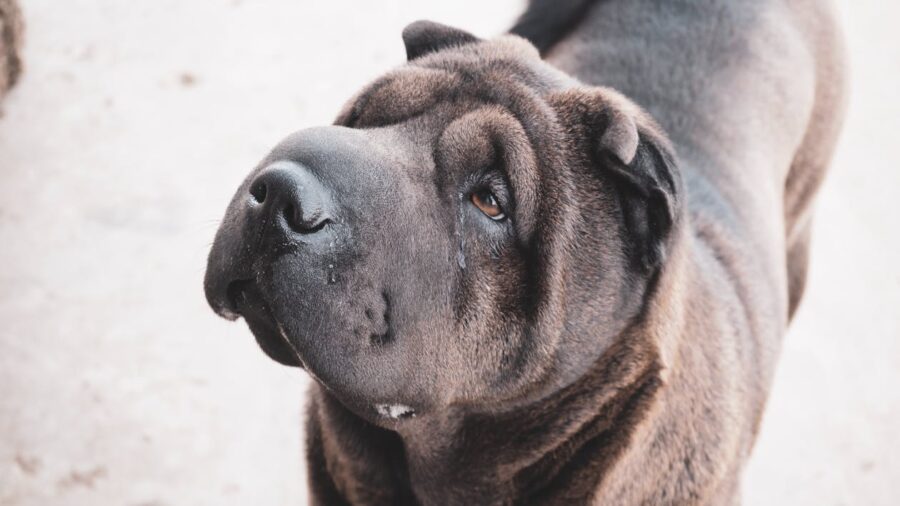Mast Cell Tumors (MCTs) | What are They?
Mast cell tumors are typically raised, red skin nodules, although they can also be found internally anywhere including the liver, spleen or in the bone marrow.
10-15% are indistinguishable from lipomas (fatty tumors – benign)
The veterinarian will likely do a fine needle aspirate on any skin level lump or bump to examine cells under a microscope for diagnosis or pathology report.
Breeds that should be more closely monitored for mast cell tumors:

- Boxer – very common, but slightly less aggressive form than in other breeds.
- Pug – very common, but tends to be much less aggressive than in other breeds.
- Shar-Pei – very common and more aggressive than in other breeds.
What can pet parents of these breeds do?
- Monitor your pet for unusual lumps and bumps and be proactive in having the veterinarian examine your dog at least annually.
Do people have mast cell tumors? MCTs are rare in people, but there is some research that shows them to be underdiagnosed in the human population
Melanoma | What is This?
Melanoma is a form of cancer that begins in melanocytes (cells that make the pigment melanin). It may begin in a mole (skin melanoma), but can also begin in other pigmented tissues, such as in the eye or in the intestines in people.
In dogs, melanomas are the most common oral tumor and may be pigmented or non-pigmented.
Presenting signs include oral bleeding, changes in the way the dog chews food, pawing at the mouth, and extreme bad breath. Melanoma of the digit can also appear as swelling or mild to moderate lameness.
Breeds that should be monitored for melanoma and are at risk of developing oral and digital melanomas:

- Miniature Schnauzers
- Scottish Terriers
What can pet parents do?
- To discover melanoma early when it is most treatable, a veterinarian should include a thorough oral and digital exam in middle aged to older animals.
- If a mass is discovered a biopsy should be performed as soon as possible.
- Early diagnosis and treatment are very helpful.
- People do also get melanoma and malignant melanoma remains more difficult to treat in both species.
Osteosarcoma (Bone Cancer) | What is This?
Osteosarcoma is a type of bone cancer that usually develops in the osteoblast cells that form bone. It happens most often in children, adolescents, and young adults. Approximately 800 new cases of osteosarcoma are reported each year in the U.S. Of these cases, about 400 are in children and teens.
In dogs, osteosarcoma typically is found after the onset of sudden lameness and occurs most commonly in the bones of the legs. There may also be pain or swelling at the site. Large breed dogs are at more risk for this cancer.
X-rays of the affected limb and views of the lungs are used for diagnostic purposes.
Breeds that should be monitored for Osteosarcoma:

- Greyhounds – Have a 25% greater likelihood of presenting with a fracture than other breeds and may have a different tumor response to chemotherapy than other breeds.
- Rottweiler – Osteosarcoma is very common
- Irish Wolfhounds – Osteosarcoma is very common
What can pet parents do?
- Currently, no known preventive strategies for osteosarcoma.
- Research for genetic markers of the disease is ongoing.
Transitional Cell Carcinoma | What is It?
Transitional cell carcinoma (TCC) is a cancerous tumor most commonly found in the urinary bladder and the urethra and is the most common malignancy of the urinary tract in dogs.
According to research conducted by Fulkerson and Knapp, 2015; Charney et. al., 2017) urinary bladder TCC’s features are papillary lesions and a thickened bladder wall. Approximately 50% of dogs will also have urethral involvement and around 30 percent of male dogs also have prostatic involvement.
On diagnosis, around 15% of patients may have regional nodal or distant metastasis, most commonly to the lungs, but may also be in skeletal bones.
Common warning signs:
- Hematuria (blood in the urine);
- Frequent, abnormal urination during the day
- Pain or difficulty urinating
- Less commonly, lameness due to bone metastasis
When urinary signs occur in middle aged to older dogs, veterinarians will recommend abdominal ultrasound and/or surgical biopsy depending on location of disease.
Breeds that should be more closely monitored for TCC:

- Scottish Terriers – 20-fold higher risk of developing TCC
- Beagles
- West Highland Terriers
- Shetland Sheepdogs
What can pet parents of these breeds do?
- Monitor your pet for the warning signs above and be pro-active in visiting the veterinarian if you see these symptoms. Often these can be simple urinary tract infections treatable with antibiotic, but don’t miss the opportunity to diagnose cancer early for best treatment results.
- Avoid exposure to lawn chemicals – Exposure to lawn chemicals is known to increase the risk for Scottish Terriers 7-fold, so avoid use of lawn care products containing 2,4 dicholorphenoxyacetic acid, 4-chloro-2-methylphenoxypropionic acid, and dicamba.
- For prevention, Scottish Terriers who consume vegetables three times per week in addition to regular dog food have a 70% reduced risk for InvUC.
Do people have TCC? According to research published in Frontiers in Oncology, 21 January 2020, Deborah Knapp et. al. there is a great need to improve the outlook for people and dogs facing urinary bladder cancer, especially for patients with urothelial carcinoma (InvUC) which is lethal in 50% of cases in people. There is strong evidence that dogs with naturally-occurring InvUC can represent a relevant predictive model for InvUC treatment and prevention.
https://doi.org/10.3389/fonc.2019.01493
Brain Tumors | What are They?
Dogs develop brain cancers (tumors) the most common of which are meningiomas (benign tumors arising from meningeal tissue of the brain) or gliomas (malignant tumors of the glial tissue of the nervous system). Dogs over 5 years of age have an increased risk of developing these tumors.
Dogs also may rarely develop neuroblastomas, tumors of neuroectodermal that originate in ganglion cells. These may appear in the craniodorsal abdominal cavity of young dogs.
What are the signs and symptoms of brain cancer?
- Seizures are the most common sign of a brain tumor. Call your veterinarian immediately if your pet with no seizure history has a seizure.
- Abnormal behavior may include increased aggression, loss of learned behavior, depression/dullness, or lethargy.
- Vision loss including trouble seeing out of one or both eyes, pupils are dilated or movement seems uncoordinated.
- Food and water intake changes – any increased or decreased hunger and thirst.
- Neck/Head pain – if a dog is tilting their head or displaying signs of pain or sensitivity in the neck.
- Restlessness – pacing or circling to one side.
- Unsteadiness – loss of balance, staggering while walking or standing up or sitting down.
- Nausea – vomiting due to unknown cause
- Other signs: weight loss or gain, a persistent cough, a wound that won’t heal.
Risk increases over the age of 5.
Breeds at greatest risk of brain tumors:

- Boxers – Boxers are prone to gliomas and can vary from benign to very aggressive.
- Some evidence exists that Golden Retrievers, Doberman Pinschers, Scottish Terriers and Old English sheepdogs may also be more prone to brain tumors.
- Collies – more likely to develop meningiomas.
- Pugs and other short nosed breeds are more likely to develop pituitary gland tumors and glial cell tumors.
See a veterinarian immediately for best prognosis through surgery, chemotherapy, radiation and/or stereotactic radiation. Diagnosis made via CT/MRI for middle aged and older pets showing neurological disorders.
Do people also have gliomas?
Yes, people do have gliomas and glioblastomas – the median survival time following best available standard of care is 14.6 months. Gliomas are one of the biggest challenges in cancer medicine and research could be advanced through comparative oncology.
According to the Pediatric Brain Tumor Foundation, every day 1 in 13 children are diagnosed with a brain tumor, the deadliest form of childhood cancer.
Gastric Carcinoma | What is It?
Gastric carcinoma is the most common neoplasm (a new and abnormal growth) in the stomach of dogs. Incidence in the general population of dogs is low, but some breeds are much more prone than others. Diagnosis is often made at an advanced stage, making prognosis poor. Gastric carcinomas make of <1% of all cancer cases. When gastric cancer is diagnosed in dogs, 70-90% show metastasis at diagnosis. Most are discovered by endoscopy; however, your veterinarian may perform an abdominal ultrasound early in the work-up if gastro-intestinal signs are found. Sometimes surgical re-section is possible.
https://onlinelibrary.wiley.com/doi/pdfdirect/10.1111/vco.12249
Common warning signs:
- Vomiting
- Diarrhea
- Bloat
- Weight loss
- Anorexia
- Lethargy
The median age of onset is 8 to 10 years of age. Males are more prone than females to developing these types of tumors.
Breeds that should be more closely monitored for gastric tumors:

- Chow
- Dutch Belgian Shepherds
What can pet parents of these breeds do?
- Monitor your pet for the warning signs above and be pro-active in visiting the veterinarian if you see these symptoms. Because gastric tumors are discovered after metastasis in many cases, prognosis is poor.
Do people have gastric tumors?
According to Hugen et. al. gastric carcinomas are the fourth most prevalent cancer in people. Onset is in middle age or older, although Familial cases can present at younger ages. Males have a stronger predilection, as do those of Asian descent. Clinical signs present later in disease progression therefore greater than 50% have metastatic disease at diagnosis. The 5 year survival rate in the Western population is 25-30%, considered very poor. Surgical re-section and chemotherapy are treatments of choice. Researchers are investigating the role of H. Pylori infection and they have identified some familial genetic markers.
How might comparative oncology research help people and pets?
Because of the similarities of this form of cancer in clinical presentation, diagnosis, histology and prognosis, canine GC may be a very valuable model for human GC.

